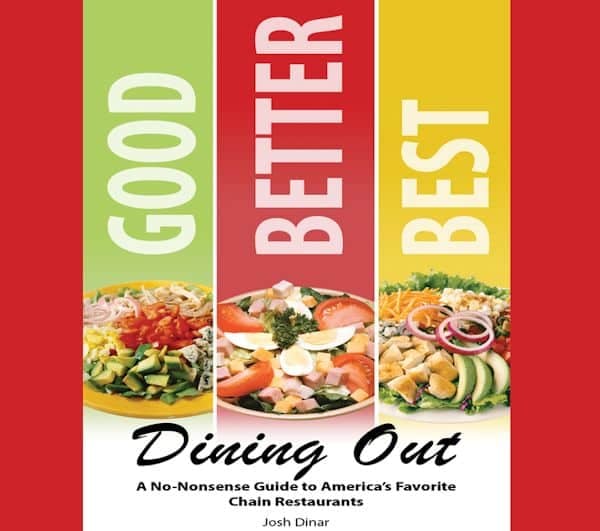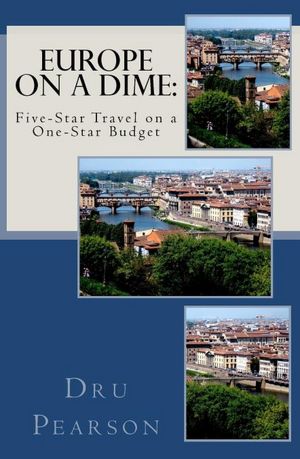Travel styles are as different as the people who travel. With this in mind, I recently read two books that don’t pretend to be for everyone and are better for it.
 Let me be clear, as clear as author Josh Dinar is in his introduction – “Dining Out, a No-Nonsense Guide to America’s Favorite Chain Restaurants” is all about taste, not calories or health. Middlebrow tastes, I might add. Otherwise how would a concoction like IHOP’s CINN-A-STACK pancakes rank best in the pancake category?
Let me be clear, as clear as author Josh Dinar is in his introduction – “Dining Out, a No-Nonsense Guide to America’s Favorite Chain Restaurants” is all about taste, not calories or health. Middlebrow tastes, I might add. Otherwise how would a concoction like IHOP’s CINN-A-STACK pancakes rank best in the pancake category?
Dinar’s book offers great value for people who seek a reliable sit-down dining experience in town or on the road. In large swaths of food-challenged America, a person’s best bet for a good meal, especially when traveling, are the very chains many big city sophisticates eschew.
Thanks to trips to North Carolina to visit aging parents, I am well acquainted with most of the 33 national chains profiled and confess an almost cult-like devotion to one, The Waffle House, proving that 30 years of living in LA have not eradicated all traces of my Southern heritage.
Dinar and his crew of reviewers are nothing if not thorough. This well-organized guide first details the history and offerings of the 33 chains, using their good, better, best ranking system to give diners an idea of what to order at each restaurant.
Next, they rank a mind-numbing 88 categories of food offerings. Want to know the best Cajun/Creole vegetarian entrée? Page 174 suggests Hooters’ Lots-a-Tots with Cajun Sauce, Mimi’s Cajun Chicken Alfredo sans the chicken or the Cheesecake Factory’s Garlic Noodles. You can find quality Asian lettuce wraps at the Hard Rock Café, P.F. Chang’s or the Cheesecake Factory. An Australian outfit, Outback Steakhouse, gets a best ranking in the American beef entrée category. Kudos to Red Robin’s Bleu Ribbon burger for its top ranking in the hamburger category. My beloved Waffle House wins best waffle, confirming what I have long known. Though the pickings be slim, this book also offers guidance for locating quality low-cal, gluten-free, vegan and vegetarian offerings.
I particularly enjoyed the sidebars accompanying some food categories, filled as they were with interesting tidbits such as the origin of the tater tot. Hint, these French fry scrapings used to be sold for cattle feed until Nephi Grigg came up with a better idea. I may never look at an avocado the same way knowing that its name came from the Aztec word for testicle.
This book celebrates American cooking, even when it’s Italian, Mexican or Chinese. Some of the concoctions, such as the California Pizza Kitchen’s Tortilla Spring Rolls with your choice of peanut or guacamole dipping sauce, prove that American ingenuity lives on. Back to the aforementioned CINN-A-STACK from IHOP, a sugar bomb that layers four buttermilk pancakes with cinnamon roll filling before drizzling them with cream cheese and a squirt of whipped cream. Though not for the faint-hearted, my office’s resident junk food junkie confirms their deliciousness. Who knew?
“Good, Better, Best” can be ordered from amazon.com or barnesandnoble.com in either paperback or e-book form for $14.24. Better yet, ask your local bookseller to order you a copy.
 Dru Pearson, author of the e-book “Europe on a Dime: Five-Star Travel on a One-Star Budget”, hates organized tours of Europe. She makes this evident as she exhorts fellow boomers to wing it sans tour bus. Me, I would have preferred she shorten her hating on tours to more quickly get to the good stuff. Pearson has written a must-read for people of a certain age or even people of all ages contemplating a non-tour trip to Europe.
Dru Pearson, author of the e-book “Europe on a Dime: Five-Star Travel on a One-Star Budget”, hates organized tours of Europe. She makes this evident as she exhorts fellow boomers to wing it sans tour bus. Me, I would have preferred she shorten her hating on tours to more quickly get to the good stuff. Pearson has written a must-read for people of a certain age or even people of all ages contemplating a non-tour trip to Europe.
Pearson has a simple premise: Follow her suggestions and you can travel Europe for less than $98 per person, double occupancy, plus airfare. Tightwad travel, as she calls it, requires planning, lots of it, and she has kindly written a step-by-step guide to the planning you will need to do. She’s walked the walk and knows her stuff. Serious travelers will want to heed her advice, for the cheaper the trip, the more trips that can be taken.
Pearson recommends that travelers begin trip planning no later than five months before departure. She leaves nothing to chance, even recommending websites that will help you compare the cost of living in various European locales. She puts the step in step-by-step, something that may frustrate the more experienced but will be heaven sent to the neophyte. Happily she has organized her book with lots of sub-headings making finding information easy.
Tightwad travel tackles the two largest expenses after airfare: lodging and food. Simply put, she believes that to hit the $98 mark, one needs to rent an apartment and eat at home. She rightly believes that staying in a home a few subway stops from tourist central and shopping like a local will give one a better sense of the country and people. I agree, having done this myself many times, but this approach is not without its drawbacks. First, in food-centric places such as France and Italy, restaurants make up an integral part of the local culture. Second, Pearson’s approach does not allow for much nightlife, and for some travelers that presents a problem. Still, it is hard to fault her approach considering the alternatives.
Part Two of “Europe on a Dime” veers off into the anecdotal on occasion while reminding readers of some key tips for independent travel. From travel insurance to pet sitting to itinerary planning, the author lists internet-based resources, going into great detail. This will be annoying to the Internet savvy but essential to those needing a little virtual handholding. She even knows about a website that tells people what and how to pack.
Always helpful, never condescending, you could do far worse in finding a book about the nuts and bolts of traveling to Europe.
“Europe on a Dime” can be downloaded from amazon.com or barnesandnoble.com for $8.99.




